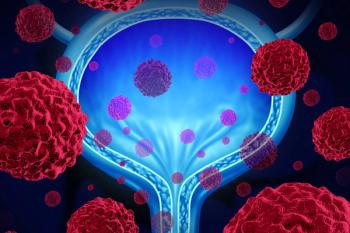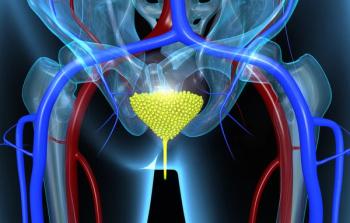
Oncology NEWS International
- Oncology NEWS International Vol 10 No 10
- Volume 10
- Issue 10
Optimizing Mitomycin Use Ups Bladder Cancer Outcome
ANAHEIM, California-In patients with superficial bladder cancer, it is possible to optimize treatment with mitomycin (Mutamycin) by enhancing the drug concentration in urine, according to the results of a multicenter study presented at the American Urological Association annual meeting (abstract 776).
ANAHEIM, CaliforniaIn patients with superficial bladder cancer, it is possible to optimize treatment with mitomycin (Mutamycin) by enhancing the drug concentration in urine, according to the results of a multicenter study presented at the American Urological Association annual meeting (abstract 776).
Experimental studies have shown that the incomplete and variable responses to mitomycin occur because of two problems: inadequate delivery of drug to the tumor site and insensitivity of the tumor to the drug. The current study addressed inadequate drug delivery, identifying several contributing factors and constructing a strategy to overcome them.
Principal investigator Jesse L-S Au, PhD, of Ohio State University, Columbus, pointed out that suboptimal concentration of mitomycin and inadequate emptying of the bladder are major problems leading to dilution of the drug and therefore diminished efficacy.
"Patients often do not have fully emptied bladders. The volume of the dosing solution is 20 mL, and some patients retain 4 or more ounces of urine," she said. "They also continue to consume beverages, which leads to further dilution of drug concentration." The other problem is that mitomycin is acid labile, meaning that it is degraded 12 times faster at below neutral pH than at a pH of 7.
Six Potential Methods to Maximize Mitomycin Treatment of Bladder Cancer
Increase the dose
Decrease the dosing volume
Dehydrate the patient
Empty the bladder under ultrasound guidance
Use sodium bicarbonate to elevate the pH and preserve the drug’s stability
Increase treatment duration from 2 to 4 hours*
*Increasing treatment duration did not yield a benefit in a computer simulation.
The investigators determined six parameters that could be changed to potentially maximize drug delivery to the tumor . They then performed a computer simulation, using a standard mitomycin protocol and changing one parameter at a time to predict the effect on outcome.
"If we increased the dose, we increased the recurrence-free rate from 20% to 25%. Then if we drained the bladder completely, we got another 5% increase. In the end, we concluded that if we changed five factors, we could go from a 20% recurrence-free rate to a 40% rate," Dr. Au said. (The sixth factor, increasing treatment duration from 2 to 4 hours, showed no improvement in outcome.)
Phase III Trial
The investigators began testing their optimized treatment strategy in 1993 in a prospective, two-arm, randomized, 14-center phase III clinical trial of 230 patients (222 randomized).
The patients had transitional cell bladder carcinoma and were at high risk of recurrence because of prior disease, multifocal tumors, and/or large primary or solitary tumors (greater than 5 cm, grade 3, or DNA aneuploidy).
Patients were stratified by disease status (primary vs recurrent), carcinoma in situ (yes vs no), tumor grade (grade 1-2 vs grade 3), and focality (unifocal vs multifocal). Primary endpoints were recurrence and time to recurrence.
The optimized arm employed a 40-mg dose and pharmacokinetic manipulations to increase drug concentration by decreasing urine volume (ie, by using the minimal 20-mL dosing volume, ultrasound-guided bladder emptying, and voluntary dehydration) and by urine alkalinization. The standard arm consisted of mitomycin 20 mg/20 mL, with no pharmacokinetic manipulations.
In the evaluable group of 201 patients, the optimized arm showed a longer median time to recurrence (29.1 vs 11.3 months) and a greater recurrence-free fraction at 5 years (42.6% vs 23.5%), compared with the standard arm. The differences were significant at P = .002, Dr. Au reported. The intent-to-treat group (n = 230) showed similar findings (P = .005).
Benefit in Subsets
Improvements were noted for all risk groups based on tumor type, stage, grade, and prior chemotherapy, Dr. Au said. (For complete results, see J Natl Cancer Inst 93:597-604, 2001.)
In patients with primary cancer, those receiving standard treatment (30 patients) experienced 20 events with a median time to recurrence of 13.4 months. (At the time of data analysis, the recurrence-free rate could not be calculated as no patients had reached the end of the 5-year follow-up period.) In the optimized treatment arm of this subset (29 patients), 12 events occurred, median time to recurrence has not been reached, and the recurrence-free rate is 52% (P = .009).
In patients with recurrent cancer, there were 50 events among patients on standard therapy and 43 among patients receiving optimized treatment. Median time to recurrence was 8.7 months vs 18.1, and percent recurrence-free was 24% and 38.7%, respectively (P = .037).
"With the optimized arm, we enhanced the recurrence-free rate from 23.5% to 42.6%. This is very close to our computer simulation. We also saw improvements across all risk factors, although statistical significance was not reached in some subgroups due to the small sample size," Dr. Au said.
The goal now, she said, is to push the recurrence-free rate closer to 100%. The investigators would also like to solve the second problem, she said, "which is how to make tumor cells more sensitive to mitomycin, possibly with an inhibitor of fibroblast growth factor."
Articles in this issue
about 24 years ago
High-Dose IL-2 Is Standard in Advanced Renal Cell Cancerabout 24 years ago
RIT Safe, Effective in Elderly and Poor-Prognosis Patientsabout 24 years ago
FDA Approves Xeloda/Taxotere Combination for Advanced Breast Cancerabout 24 years ago
ODAC Recommends Approval of Radiolabeled Zevalinabout 24 years ago
Proteomics Moves From the Laboratory to Clinical Researchabout 24 years ago
Radiotherapy Not Needed in Older Lumpectomy Patients With Early Cancerabout 24 years ago
Raltitrexed + Oxaliplatin for Advanced Colorectal Cancerabout 24 years ago
Mental Fatigue Worries Chemotherapy Patientsabout 24 years ago
Patients Urged to Work With Professionals Against Fatigueabout 24 years ago
NCI Director Resigns to Head New Scientific InstituteNewsletter
Stay up to date on recent advances in the multidisciplinary approach to cancer.


















































































